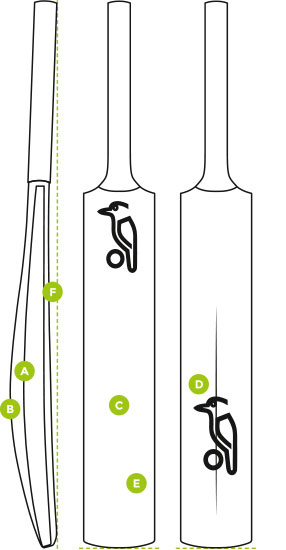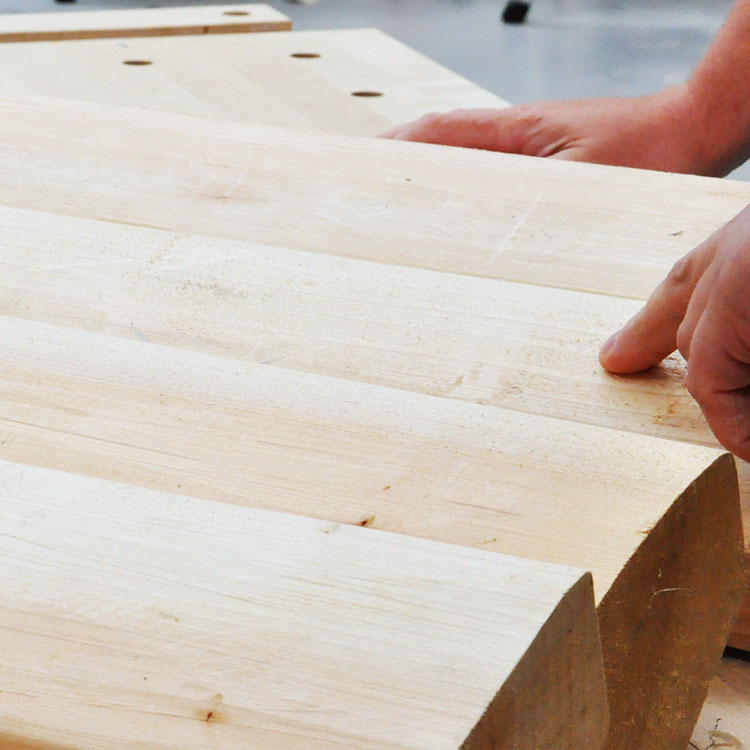


Cricket Bat Profile
Cricket is a technical sport with technical products, but what do all the terms mean? The following is an insight into the anatomy of a Kookaburra cricket bat and will hopefully assist when selecting a Senior or Junior cricket bat size to suit you.
A — EDGE PROFILE
Kookaburra's big edge profile increases from the shoulders and maximises at the swell, generating supreme balance with an extended sweet spot that covers the entire width of the blade.
B — SPINE PROFILE
Kookaburra’s super spine profiles adopt traditional shaping characteristics and operate in unison with the edge profile of the bat. This creates a huge apex with unrivalled amounts of power and exceptional pick up.
C — SWEET SPOT
The position in the blade where performance is at its maximum. Kookaburra bats are designed to maximise the size of the sweet spot, allowing the middle of the bat to be spread further across the blade and ensuring that off centre strikes perform better.
D — SCALLOP
In the quest to maximise profile, using scallops either side of the spine allow the apex to be extended without dramatically increasing weight. Scallops also maximise edge profile and reduce rotation of the blade in off-centre hits, minimising power loss.
E — FACE PROFILE
The modern game revolves around the thickness of the blade. Kookaburra have developed two types of face profiles to suit these demands:
Flat Face — a level striking area that allows more mass to be retained in the back of the bat to, in turn, maximise power profile.
Rounded Face — a slightly rounded face favoured by more traditional players. Gives a familiar look but yields a less expanded profile.
F — BOW
The curvature of the bat from the tip of the handle to the end of the toe. Designed to enhance the position of the hands by placing them ahead of the ball – an essential for optimum stroke play.
Cricket Bat Sizes
Below is our recommendation on the appropriate bat size based on player height. This guide can be used for all Junior and Senior cricket bats.
| BAT SIZE | PLAYER HEIGHT (cm) | PLAYER HEIGHT (in) |
|---|---|---|
| Size 1 | - 130 | - 4'3" |
| Size 2 | 130 - 137 | 4'3" - 4'6" |
| Size 3 | 137 - 145 | 4'6" - 4'9" |
| Size 4 | 145 - 152 | 4'9" - 5' |
| Size 5 | 152 - 160 | 5' - 5'3" |
| Size 6 | 160 - 165 | 5'3" - 5'5" |
| Harrow | 165 - 170 | 5'5" - 5'7" |
| Small Adult | 170 - 175 | 5'7" - 5'9" |
| Short Handle | 175 - 183 | 5'9" - 6' |
| Long Blade | 183 + | 6' + |

WEIGHT & PICK UP
The ‘holy grail’ of bats is one with a massive profile and a very light ‘dead weight’, but this is exceptionally hard to find.
There is much discussion about heavier bats and larger edge profiles, and how these will hit the ball further. At Kookaburra, we do not totally subscribe to this theory. Clearly, If you choose a lighter bat then you will most likely need to compromise slightly on the thickness of the overall profile. Rest assured, this is not always a problem. We all have different physiques and sizes and we strongly believe that to get the best performance out of a bat, the most essential element is to choose one that feels the right weight for you. This will help you to time the ball better and ultimately make more runs!
It is interesting when a player stipulates that they must have an exact bat weight. If a 2lb 9oz and a 2lb 10oz bat weight were placed in front of the player, it is unlikely that they would be able to tell the difference. We feel ‘pick up’ is more important than ‘dead weight’ as the pick up determines how the bat will feel in play. Nobody can tell you what the right pick up is for you, or the exact weight you should use – it is a question of what feels right for you.
SHAPE AND PROFILE
It is often claimed that bats are specifically designed for either front or back foot play. In reality, although a shape can be better suited to the type of wicket you normally play on, we all have to play off both the front and back foot. Therefore, it is best to choose the bat that just feels right for you.
All players differ slightly in the way they play and as such, are likely to hit the ball in slightly different areas of the bat. Whilst it is impossible to cater for every impact area, we recommend choosing a bat that has wood focused in your normal impact position. This will greatly improve the chance of the bat being a correct fit for you. To ensure the longevity of your cricket bat, always follow appropriate bat care instructions.
Bat Grade & Appearance
Bat prices vary significantly and are all effectively pieces of wood, but we would argue that a more expensive bat will perform better than a cheaper one. For example, we would expect a bat made from Grade 1 wood to perform better than a bat made from Grade 3 wood. The potential performance of every Kookaburra handmade bat is evaluated constantly throughout the manufacturing process by our master bat makers. They evaluate the bat on the basis of how it ‘drives’, so you can be sure that the bat you choose will perform just how you would expect from that particular grade.
In all our years of experience in making cricket bats, we feel that cosmetic appearance has little correlation with bat performance. It used to be felt that thin grain bats were the best performing, but that is not necessarily the case and they can tend to break more quickly. Conversely, although wider grain bats may be slightly harder to start with, after playing in they are generally stronger pieces of willow and can perform just as well.
The number of grains in a bat is a much debated issue (a grain is regarded as a year in the life of a tree) and there was a school of thought that eight straight grains on the face produced the perfect bat. However, over the years the ever increasing demand for willow has created a scenario in which trees reach maturity more quickly. This means that there are fewer/wider grains and consequently the definition of grading and grains have evolved with it. During the production process, our bat makers will evaluate every cleft of wood to determine what model we should produce from it. You can be sure that the quality of any Kookaburra bat is the best you can get from that particular quality of willow.
Ultimately, the most important factor when choosing your bat is to ensure that it feels right for you. In order to maximise your performance it is important to consider what you want from your bat and how you play the game.
GRADE 1
The most expensive willow and arguably the best looking blade. There may be some red wood evident on the blade and generally there will be at least 6 fairly straight grains visible on the face. There may be a small knot or speck in the edge or back of the bat but the playing should be clean.
GRADE 2
Excellent quality blade but usually more red wood may be visible than on a grade 1 which does not affect the playability of the bat. Similar number of grains to a grade 1 with potentially the odd blemish or butterfly in the grain on the face.
GRADE 3
The most extensively used grade of blade which offers excellent value for money. A grade 3 blade may have up to half the face in a tint/red wood colour but this does not affect playability. This grade will have around 5 grains on the face that may not be that straight and there is likely to be some specks or butterfly marks on the grains on the face of the bat.
GRADE 4
Usually over half of the blade may have a discoloured area but the product playability should not be affected. There are often only 4 grains and there are more butterfly stains and marks on the face of the bat.
GRADE 5
This grade is produced during our production process and it is basically similar to a grade 4 but may have more stain in the wood so cosmetically will not look as good.

